The problem statement of self-driving cars revolves around creating a vehicle capable of navigating and operating without human intervention. This complex challenge encompasses various technical, ethical, and societal hurdles that must be overcome to achieve fully autonomous driving. From sensor technology and decision-making algorithms to infrastructure requirements and public acceptance, the journey to autonomous vehicles presents a multifaceted problem statement.
Navigating the Complexities of Autonomous Vehicle Development
Developing self-driving cars presents a range of intricate challenges that demand innovative solutions. The core issue lies in replicating and even surpassing human driving capabilities, a task requiring advanced technology and sophisticated algorithms. These vehicles must perceive their environment, make decisions based on that perception, and then execute those decisions, all while maintaining safety and efficiency.
Sensor Technology and Data Processing: A Crucial Piece of the Puzzle
One of the most significant hurdles in developing self-driving cars is creating a robust and reliable sensor system. These sensors act as the “eyes” of the vehicle, collecting data about the surrounding environment. This data, often massive in volume, needs to be processed in real-time to enable quick and accurate decision-making. Factors such as weather conditions, lighting, and the presence of obstacles can significantly impact sensor performance, demanding sophisticated algorithms to filter and interpret the data accurately.
Decision-Making Algorithms: The Brain of the Self-Driving Car
The ability to make informed decisions based on sensor data is crucial for autonomous vehicles. This requires sophisticated algorithms that can analyze the environment, predict the behavior of other road users, and plan the vehicle’s trajectory accordingly. These algorithms must be capable of handling a wide range of scenarios, from simple lane changes to complex intersections and unexpected events. The safety and reliability of these decision-making systems are paramount, as they directly impact the vehicle’s ability to navigate safely and efficiently.
Infrastructure and Communication: The Supporting Ecosystem
The successful deployment of self-driving cars requires more than just advanced vehicle technology. It also necessitates a supportive infrastructure, including well-maintained roads, clear signage, and reliable communication networks. Vehicle-to-everything (V2X) communication, which allows cars to communicate with each other and with infrastructure elements, is crucial for enhancing safety and efficiency. This interconnected ecosystem plays a vital role in enabling autonomous vehicles to operate seamlessly within the existing transportation network.
 V2X Communication in Autonomous Vehicles: An Illustration
V2X Communication in Autonomous Vehicles: An Illustration
“The key to unlocking the full potential of self-driving cars lies in creating a robust and reliable ecosystem that supports their operation,” says Dr. Emily Carter, a leading researcher in autonomous vehicle technology at the Institute for Transportation Studies.
Addressing Ethical and Societal Concerns
Beyond the technical challenges, the problem statement of self-driving cars also encompasses ethical and societal considerations. Questions surrounding liability in accidents, data privacy, and the impact on employment are crucial to address. Public acceptance and trust are essential for the widespread adoption of this transformative technology.
Public Perception and Acceptance: Building Trust in Autonomous Vehicles
Gaining public trust is critical for the successful integration of self-driving cars into society. Concerns about safety, job displacement, and the potential for misuse need to be addressed transparently and effectively. Educating the public about the benefits and limitations of autonomous driving is essential for fostering acceptance and ensuring a smooth transition.
“Building public trust is as important as developing the technology itself. Open communication and transparency are key to addressing public concerns and fostering acceptance,” adds Dr. Carter.
The Problem Statement of Self-Driving Cars: A Continuous Evolution
The problem statement of self-driving cars is not static; it continues to evolve as technology advances and new challenges emerge. The pursuit of fully autonomous vehicles requires ongoing research, development, and collaboration across various disciplines. As we move closer to realizing the vision of self-driving cars, addressing the multifaceted challenges outlined in this problem statement is crucial for shaping a future where autonomous vehicles can safely and efficiently transform transportation.
 The Future of Self-Driving Cars: A Conceptual Image
The Future of Self-Driving Cars: A Conceptual Image
In conclusion, the problem statement of self-driving cars encompasses a complex interplay of technical, ethical, and societal challenges. From developing reliable sensor systems and decision-making algorithms to addressing public concerns and building a supportive infrastructure, the journey towards fully autonomous driving requires continuous innovation and collaboration. If you are facing any challenges related to your car, feel free to reach out to us at Autotippro. Our team of experts is ready to assist you. Contact us at +1 (641) 206-8880 or visit our office at 500 N St Mary’s St, San Antonio, TX 78205, United States.
“Remember, the success of self-driving cars hinges on our ability to address the multifaceted challenges inherent in their development,” concludes Dr. Michael Johnson, a renowned automotive engineer specializing in autonomous vehicle technology.
FAQ
-
What is the main challenge in developing self-driving cars?
Creating a vehicle capable of safely and reliably navigating and operating without human intervention is the core challenge. -
What role do sensors play in self-driving cars?
Sensors act as the “eyes” of the car, collecting data about the environment, which is then processed by algorithms for decision-making. -
Why is public acceptance important for self-driving cars?
Public trust is essential for the widespread adoption and integration of self-driving cars into society. -
What is V2X communication?
Vehicle-to-everything communication allows cars to communicate with each other and infrastructure, improving safety and efficiency. -
Are self-driving cars completely autonomous yet?
No, the technology is still evolving, and fully autonomous driving remains a work in progress. -
What are some ethical concerns surrounding self-driving cars?
Ethical concerns include liability in accidents, data privacy, and the potential impact on employment. -
How can I get assistance with car-related problems?
You can connect with AutoTipPro at +1 (641) 206-8880 or visit our office at 500 N St Mary’s St, San Antonio, TX 78205, United States.







Leave a Reply